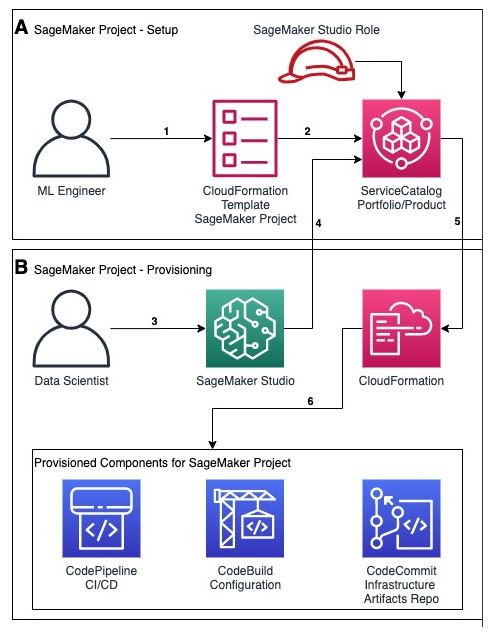


Generally any project setup aims at solving a given corporate problem. A big project may have multiple smaller projects within it, with each smaller project have a definate objective achieving a clearly defined performance index. Some of the common problems faced by various corporates across many different industries are but not limited to customer retention strategies, increase in profit margins, customer attrition, product development and so much more. Artificial intelligence is being adopted across various industries as a proven concept that addresses these problems with guaranteed return on investments. You have a data lake, you have a machine learning pipeline but what would be the best strategy to deliver these AI driven solutions to market. SageMaker projects is one of the best strategies deployed
What
SageMaker projects helps organizations setup and standardize developer environments for Data Scientists and CI/CD systems for MLOps Engineers. Projects also helps organizations setup dependency management, code repository management, build reproducibility and artifact sharing.
SageMaker Projects

SageMaker projects build on SageMaker Pipelines by providing several MLOps templates that automate model building and deployment pipelines using continuous integration and continuous delivery (CI/CD). SageMaker Projects help organizations set up and standardize developer environments for data scientists and CI/CD systems for MLOps engineers. Projects also help organizations set up dependency management, code repository management, build reproducibility, and artifact sharing.
With SageMaker Projects, MLOps engineers and organization admins can define their own templates or use SageMaker-provided templates. The SageMaker-provided templates bootstrap the ML workflow with source version control, automated ML pipelines, and a set of code to quickly start iterating over ML use cases.
You can provision SageMkaer projects from the AWS Service catalog using custom or SageMaker provided templates. With SageMaker projects, MLOps Engineers and Organization admins can define their own templates or use SageMaker provided templates. The SageMaker provided templates bootstrap the ML Workflow with source version control, automated ML pipelines, and a set of code to quickly start iterating over ML use cases.
When to use SageMaker Projects
So of the justification for using SageMaker Projects are:
SageMaker Projec Collaboration
SageMaker Projects can help you manage your Git repositories so that you can collaborate more efficiently across teams, ensure code consistency, and support CI/CD. SageMaker Projects can help you with the following tasks:
Typical SageMaker Project
A typical SageMaker Project would consist of:
SageMaker Project Identity
Each SageMaker project has a unique name and ID that are applied as tags to all of the SageMaker and AWS resources created in the project. With the name and ID, you can view all of the entities associated with your project. These include:
Practical Implementations
Sources